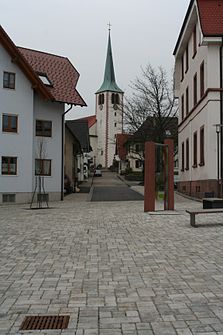Ulm (Renchen)
|
Ulm
City of Renchen
|
|
|---|---|
| Coordinates: 48 ° 34 ′ 44 " N , 8 ° 2 ′ 59" E | |
| Height : | about 163-176 m above sea level NHN |
| Residents : | 2050 |
| Incorporation : | 1st January 1975 |
| Postal code : | 77871 |
| Area code : | 07843 |
|
Parish Church of St. Mauritius and the village square
|
|
Ulm is a district of Renchen in the Ortenaukreis ( Baden-Württemberg ).
history
Ulm is one of the oldest settlements in the area. The place name goes back to the Indo-European word root * uel- (turn, wind, wallow) and thus refers to a water body name.
The first documentary mention of Ulm (as Ulmena ) dates back to 1070 in a deed of donation to the Principality of Strasbourg . In the documents of the following centuries, the place was used in different spellings, such as Ulmen 1270, Ulme 1285 or Ulma 1347.
The Strasbourg bishop set up his first administration in Ulm in the Renchtal and the place became the seat of its own court made up of mayor, staff holder and 10 twelve. The "court" included the places Erlach , Haslach , Mösbach , Ringelbach, Stadelhofen and Tiergarten. After several changes of ownership, Ulm again belonged to the diocese of Strasbourg from 1239. Until the end of the 14th century, Ullenburg was the seat of the Bishop of Strasbourg, who administered the Ullenburg Bailiwick from there .
With the Reichsdeputationshauptschluss , the Strasbourg office of Oberkirch, together with other Strasbourg-episcopal possessions in the Ortenau, came to the new Electorate of Baden . In 1975 Ulm was incorporated into the city of Renchen as a district next to Erlach.
The Ulm district has had its coat of arms since 1907. It is in silver and shows an apple tree with red fruits on green ground.
On January 1, 1975, Ulm was incorporated into Renchen.
Location and settlement
Ulm lies at the foot of the Black Forest . It consists of the hamlets Armenhöfe, Kaier (Keyer 1560, Keyher 1592), Kolbenhalde (piston stop, piston cell (?) 1463), Reiersbach and Weingarten (Wingarten 1496) and the Rothof farm (Roth 1669).
Agriculture is particularly specialized in fruit and wine growing ; the landscape is characterized by many orchards and extensive vineyards. Some of the fruit is used by the approximately 120 severance payment distilleries in Ulm as raw material for the production of fruit brandies .
church
A church and a pastor in Ulm were mentioned for the first time in 1274, although originally the parish of Ulm also included Renchen (until 1317), Erlach (until 1861), Mösbach (until 1863), Stadelhofen (until 1864), Tiergarten (until 1872) and Haslach belonged. In addition, there was a Capuchin monastery in Ulm in the 18th century . The Catholic parish church of St. Mauritius was built in 1820, although the tower is older. The lower part of the tower dates from 1416. The organ was delivered by Jacob Forrell after twelve years of construction in 1873 and is largely original. Later conversions were made in 1991 by Georg Jann to the status of 1873. Ulm has kept a church register since 1655.
Ulm today
Ulm has around 2050 inhabitants today. Major investment projects in recent years were the construction of the sports hall and the renovation of the former community hall, which once served as a fruit collection point and was converted into the Ullenburg hall for cultural events. Numerous canal and road construction measures were carried out as well as the development of building areas, most recently the “Braite Ost” area with 100 residential units. The town has its own brewery, the Bauhöfer family brewery, which sells its beer under the “Ulmer” brand. The automotive supplier Erdrich Umformtechnik is also based in Ulm.
In 2008, Ulm took part in the competition “ Our village should become more beautiful ”. For this event, the village square around the school and town hall was redesigned.
Web links
Individual evidence
- ↑ a b c Ulm local authority. Retrieved September 10, 2019 .
- ↑ Hans-Martin Pillin: The Grimmelshausen town Renchen and its history. Vol. 1: From the beginning to the end of the episcopal Strasbourg rule in 1803. Reiff Druck Offenburg 1992.
- ^ Federal Statistical Office (ed.): Historical municipality directory for the Federal Republic of Germany. Name, border and key number changes in municipalities, counties and administrative districts from May 27, 1970 to December 31, 1982 . W. Kohlhammer, Stuttgart / Mainz 1983, ISBN 3-17-003263-1 , p. 514 .
- ↑ http://mortenau.de/index.php?gem=&ort=&n=Ortenau.Renchen
- ↑ renchen.de: Catholic Church St. Mauritius Ulm , accessed on March 31, 2020

